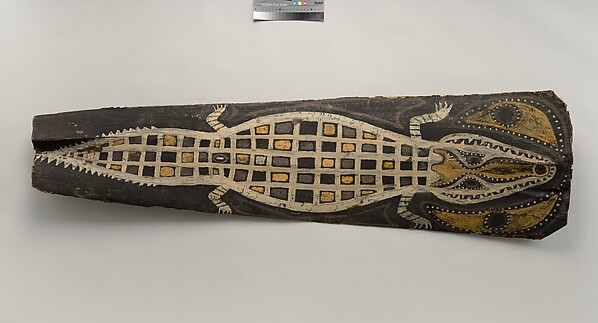This was the last talk I saw at the meeting and was a perfect way to wrap things up, with a travelogue-slash-fascinating research project on the materials and techniques of Aboriginal paintings from the northern part of Australia. Narayan traveled to various art centers and museums to look at and sample pre-1960s paintings, talk to artists and gather local materials. He took about 200 samples from 50 paintings (including some from Harvard’s collection), the oldest from circa 1878. He also obtained materials from artists working today, some of whom took him around to gather materials from local sources, including the beaches of Bathurst Island (part of the Tiwi Islands off the coast of the Northern Territories – thanks Google Maps!). Back at Harvard, he and his colleagues (co authors were Katherine Eremin, Daniel P. Kirby & Georgina Rayner) gathered information on pigments, binders and other materials present that may indicate previous treatments. Narayan pointed out that only two samples of similar paintings had been analyzed and published before, such that this study presents entirely new information.
Of particular interest was the investigation into possible binders. Oral histories and documentary evidence recorded various possible binders, including turtle eggs and orchid mucilage, but it was generally thought that paintings made before the arrival of missionaries in the 1920s didn’t have binders at all (a similar question has been on my mind regarding the paintings made in the Sepik River region of Papua New Guinea). Binders were present in 77% of the samples analyzed. No proteins, waxes, fats or blood were detected. The analysis of the oldest paintings did reveal the presence of orchid juice, confirming that binders were in use that early. The techniques of using orchid mucilage could vary; the sticky juice could be mixed with the pigment, or laid down first before applying the pigments mixed in water.
As expected the pigments were largely ochres, and Narayan noted that the trace elements present in the samples provide a fingerprint that can in theory be used to begin to trace the occurrence of different ochres in different areas, but that more study and sampling is necessary to pursue this.

Other interesting findings included the use of dry cell batteries as a source for black manganese and zinc pigments on paintings from Groote Eylandt (yes a very great big island off the east coast of the Northern Territories); this area also shows the use of natural manganese-rich ores and charcoal for black pigments. A curious silver oil-resin paint on two paintings from the 1920s turned out to correlate with the roof repainting of a nearby lighthouse at the same time. The presence of DMP (dimethyl phthalate) in some paintings prior to 1957 resulted from the liberal use of insect repellent (FYI this is the main ingredient in Avon’s Skin-so-Soft; it fell out of use when DEET was invented). The presence of nitrocellulose on Groote Eylandt paintings was connected to records from the 1948 expedition suggesting that they had been consolidated with Duco.
As always, research continues, and Narayan mentioned that they would be looking further into the use of gums and of bloodwood, though I didn’t get down any details on that (I hadn’t actually planned to blog the talk, so apologies for any lacunae!). Also, I’m pretty sure there was a crocodile sighting mentioned, but that too didn’t make it into my notes, so here’s one of my favorites for good measure…


